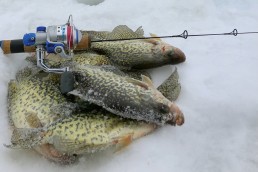Love Those Winter Crappies
SHARE THIS POST
During winter, ice fishing and crappies just naturally go together. Yes, there are other fish in the sea, but for me, I’d rather chase crappies than any other species.
There are several reasons I like to target crappies in the winter. One has to do with their excellent reputation in the frying pan. It is hard to beat the taste of fresh crappies.
Another reason is their willingness to bite during the daylight hours. I will not argue that they do bite better in low-light conditions at sunrise and sunset. However, as a rule, if I can locate crappies during the day, I can get some of them to bite. That brings me to the location part of why I like to chase winter crappies.
Most of the lakes I fish during the hardwater season have mediocre water clarity. This creates a situation that limits weed growth under the ice. With limited weed options for cover and security, crappies move to the deep basins where they suspend just off the bottom.
Depending on the lake, the deep basins I fish may range anywhere from 25 to 45 feet. Although I occasionally fish in 45 feet for crappies, it is not my preference. These really deep fish are hard to catch and very difficult to release due the pressure change experienced during the extreme depth change. With that said, there are times when these deep fish are cooperative.
One of the best things about targeting deep basin fish is the ability to locate them with some ease. By looking at a lake map, you can easily pick out deep holes where the crappies may be lurking. Although they can be found in the very deepest part of the basin, this is usually not the case. I prefer looking on the edges of the basin where the depth is starting to shallow up.
Last winter, we targeted crappies on a small lake with no public access. By looking at a map, we quickly located a promising basin to start our search. The map also showed a little finger of deep water that extended out from the basin. This irregularity proved to be a great spot as it was loaded with suspended crappies.
Are you enjoying this post?
You can be among the first to get the latest info on where to go, what to use and how to use it!
If the ice is smooth, it is easy to clear off some snow and take readings right through the ice with your Vexilar. By pouring a small puddle of water on the ice, the transducer will read through the ice and show any fish suspended off the bottom. By working as a team, it doesn’t take long to search a large area in a short time, even if you are drilling holes.
Suspended crappies are usually on the move. It is normal to have to make minor location adjustments as the crappies roam around. If you don’t have fish showing on your electronics, you aren’t going to catch any.
Many times, I have been successful by searching through a cluster of fishing shelters on the ice. The deep basin haunts of winter crappies are usually not a secret as they tend to use the same locations year after year.
During winter, crappies can also be found in weed beds on some lakes, especially when the water is extremely clear. However, my experience has taught me that by targeting deep basins, I find fish faster and have more success.
Interested in fishing a different location this season? You’ll find plenty of suggestions in every issue of MidWest Outdoors. Subscribe on our website.
MWO
SHARE THIS POST
You may also like...
Nothing found.
Did you enjoy this post?
You can be among the first to get the latest info on where to go, what to use and how to use it!
Jerry Carlson
Jerry Carlson began his writing career in 1987 and covers both hunting and fishing topics. He currently writes for numerous media outlets and does radio work with WJON AM in St. Cloud, Minn. He has authored a book called Details for Locating and Catching Fish.
